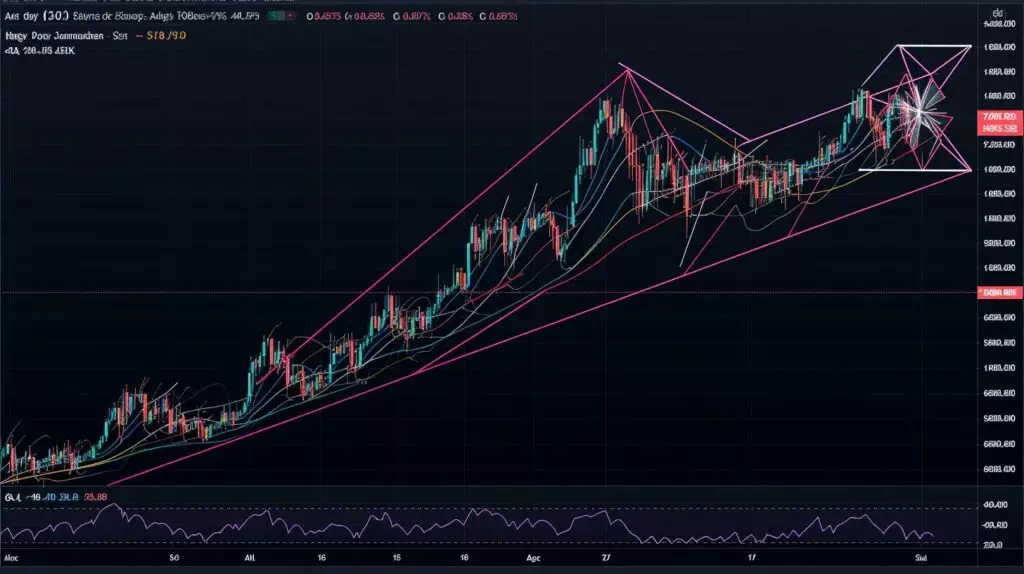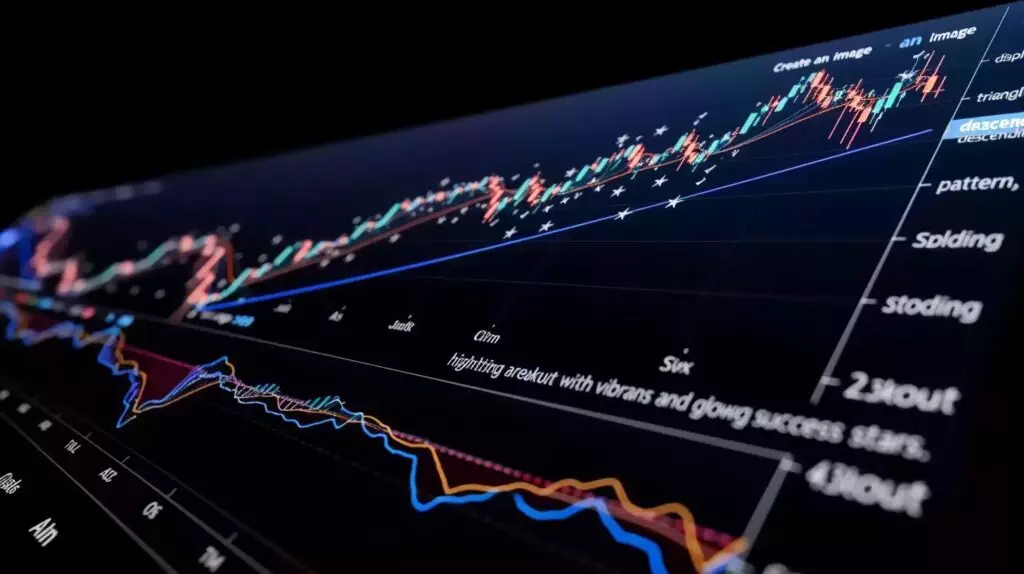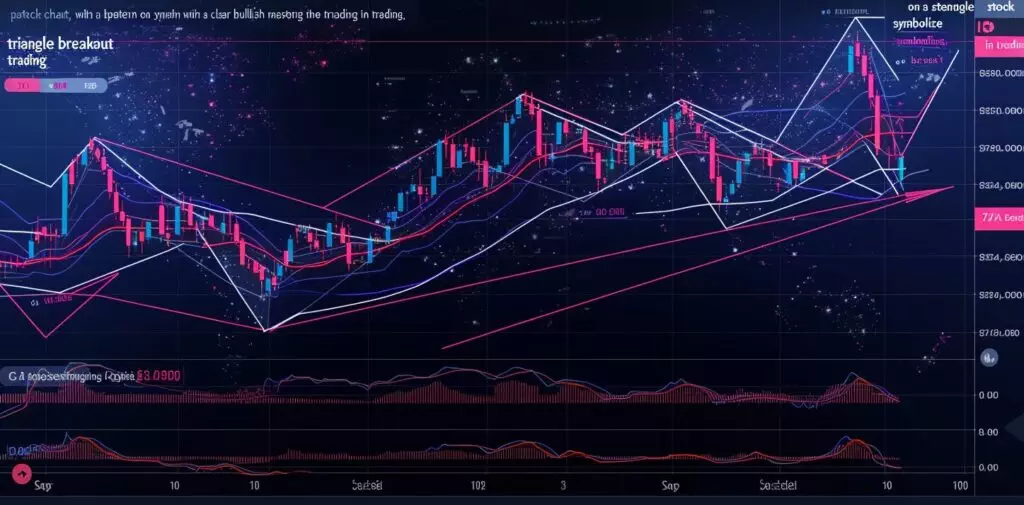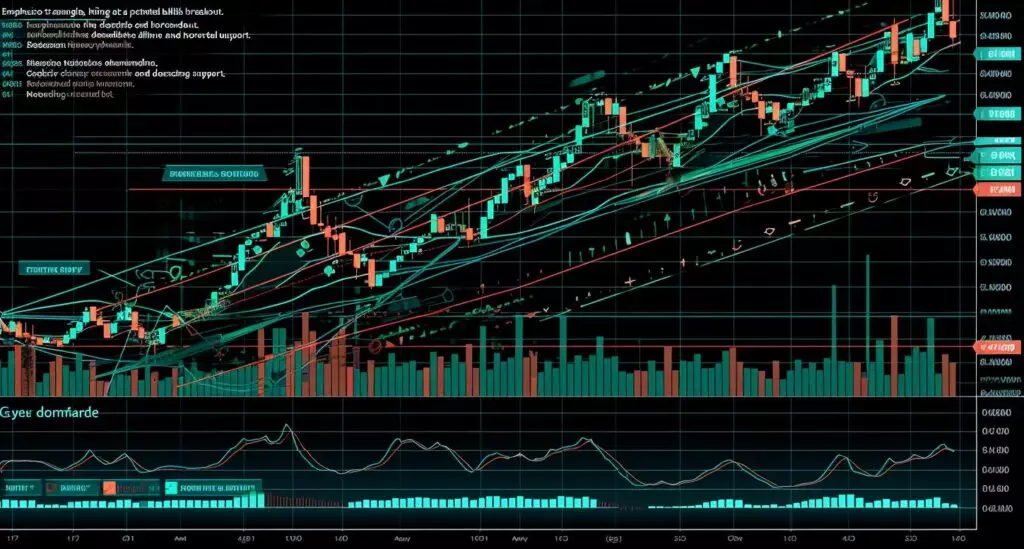Are you aware that almost 60% of descending triangle patterns yield a bearish breakout? It’s important to note, however, that the remaining 40% might possibly lead to powerful bullish breakouts from descending triangles, albeit less frequently. Proper identification and strategic application of these patterns can indicate high potential for notable positive results.
We’ll unpack the intricacies of these patterns, their identification, and crucially, how to time your trades when an end of a downtrend in a descending triangle appears. Buckle up as we delve into this complex and intriguing aspect of technical analysis in our ‘Descending Triangle Bullish’ guide.
Key Takeaways
- The descending triangle pattern is generally viewed as bearish, signaling potential price drops.
- The descending triangle forms when the price action narrows between a falling trendline and a horizontal line.
- The descending triangle reversal pattern usually forms involving a series of lower highs and a horizontal lower trendline.
- A descending triangle formation is characterized by a flat bottom and a top trendline sloping down.
Understanding the Descending Triangle Chart Pattern

Let’s dive into understanding the descending triangle pattern, a key formation in technical analysis that differs significantly from its counterpart, the ascending triangle pattern. While both are critical to trading, they indicate different market sentiments.
The descending triangle pattern formation is generally viewed as bearish, signaling potential price drops. This pattern is considered distinctive since it consists of a horizontal line, representing a support level that price struggles to break below and a descending trend line that highlights decreasing highs. The pattern gets its name from the shape these lines form, similar to a descending upper, when drawn on a chart.
The descending triangle pattern isn’t just about lines and shapes; it’s about market psychology. The situation reflects a tug-of-war between buyers and sellers, similar to when a reversal pattern occurs at the bottom. The lower highs in the pattern used suggest sellers are gaining control, yet the ability of the price to maintain a certain level indicates some resilience among buyers, much like what you’d see when a pattern emerges. This tension builds until a breakout occurs.
How to Identify a Descending Triangle in a Chart

The descending triangle forms when the price action narrows between a falling trendline connecting lower highs and a horizontal line connecting the swing lows. This pattern implies that sellers are more aggressive than buyers, leading to a potential bearish breakout.
It is important to know that this pattern indicates that the descending triangle can also be bullish. In a descending triangle bullish scenario, buyers may eventually take over, leading to a triangle breakout to the upside. We need to be vigilant and not jump to conclusions too early, as false breakouts are common pitfalls.
To identify a descending triangle, look for a series of lower highs that form the upper trendline and a consistent support level that forms the lower trendline. Volume is a crucial indicator to consider. A decrease in volume as the descending triangle in a chart develops, followed by a sharp increase during the breakout, can confirm the pattern.
Additionally, the breakout point should ideally be two-thirds to three-quarters of the way through the pattern. If it occurs too early or too late, it might not provide a reliable signal. Another tip is to wait for the price to close outside the triangle before taking action, as intraday breaks can often be misleading.
Decoding the Descending Triangle Reversal Pattern

A descending triangle bullish pattern involves a series of lower highs, which form the triangle’s downward sloping upper trendline, and a horizontal lower trendline. This pattern typically implies a bearish sentiment. However, when a reversal occurs, we see a shift in market sentiment, and the pattern becomes bullish.
Decoding the descending triangle reversal pattern involves understanding the shift in investor sentiment. When the price breaks upward through the upper trendline, it signals a potential bullish reversal. This triangle breakout might suggest a change in the market trend from bearish to bullish.
However, the reliability of a descending triangle reversal pattern isn’t guaranteed. Some factors can influence this. For instance, the volume of trades during the breakout can provide a clue about its reliability. A high volume breakout is generally considered more reliable.
Also, the length of the pattern formation plays a part. The longer the pattern formation, the more significant the subsequent breakout tends to be.
Furthermore, a false breakout, where the price breaks out of the regular descending triangle pattern but quickly returns, can sometimes occur. It’s crucial to wait for confirmation before considering the breakout reliable.
Descending Triangle Breakout: Reading the Signals and Timing Your Trade

In trading the descending triangle breakout, one of the bearish patterns, it’s essential to accurately read the signals and time your trades for optimal results. Understanding the descending triangle bullish pattern, which is a pattern at the bottom end, is key to recognizing the breakout moment.
A descending triangle formation is characterized by a flat bottom and a top trend line sloping down. This pattern signals a potential breakout from the descending triangle when the price breaches the bottom line.
To make this process of identifying when a pattern occurs easier and more accurate, here are some tips:
- Watch for a breakout. Observe the descending triangle, typically downward, indicating a strong sell signal.
- Monitor the volume. A high trading volume can confirm the breakout.
- Be patient. Wait for the price to close below the flat bottom of the triangle to confirm the breakout.
- Calculate the price target. Do this by subtracting the highest point of the triangle from the breakout point.
After the triangle breakout, we must manage our risk, especially if the pattern forms at the bottom end of a downtrend. One strategy is to look for the upside from the descending triangle and place a stop-loss order slightly above the last swing high before the breakout. This protects us from a false breakout and limits potential losses.
Trading for Success: The Descending Triangle Pattern Breakout Strategy

For risk-savvy traders seeking substantial profits, mastering chart patterns is the ideal guide, especially when dealing with the descending triangle pattern strategy. This pattern is an effective tool for predicting potential price breakouts. It’s essential to understand the ins and outs of the regular descending triangle pattern strategy to maximize your profits.
We’ll explore how to trade the descending triangle pattern, emphasizing proven strategies for success. In essence, the key lies in identifying the pattern early, ensuring accurate timing, and managing risk in cases where a reversal pattern at the bottom persists. We’ve analyzed various cases of successful trades using this strategy, providing you with practical knowledge.
Remember, the descending triangle pattern isn’t a guarantee of success but a powerful tool in your trading arsenal. As always, patience and discipline are critical in this potentially lucrative game of trading the pattern to anticipate potential breakouts.
Conclusion
In conclusion, mastering the descending triangle breakout, a common chart pattern with technical indicators, can significantly improve our trading success.
By understanding and identifying the pattern, decoding its reversal, and timing our trades, we’re well-positioned to capitalize on the market’s movement.
With the right strategies using chart patterns used in technical analysis, we can turn the descending triangle, a seemingly complex pattern, into a powerful tool in our trading arsenal.
Remember, practice makes perfect, so keep analyzing those charts and soon, we’ll be reaping the rewards.
Frequently Asked Questions
What is a descending triangle pattern?
A descending triangle is a bearish chart pattern that is formed by a series of lower highs and a horizontal support line. It indicates that sellers are gradually gaining control and that a potential breakdown is imminent.
How can I trade a descending triangle pattern?
Traders can trade a descending triangle pattern by entering a short position when the pattern indicates that the bullish price breaks below the horizontal support line. They can set a stop-loss above the recent swing high and target a profit based on the pattern’s height.
What does a descending triangle tell traders?
A descending triangle pattern tells traders that the market is experiencing increased selling pressure and that a potential downside breakout is likely. It is considered a bearish continuation pattern.
What is the significance of a descending triangle pattern at the bottom of a downtrend?
A descending triangle pattern at the bottom of a downtrend is a potential reversal pattern. It indicates that the selling pressure may be nearing exhaustion and that a trend reversal to the upside could be on the horizon.
How can I use the descending triangle pattern in my trading strategy?
Traders can use the descending triangle pattern to anticipate potential downside breakouts and plan their entry and exit points accordingly. They can also apply other technical indicators to confirm the signals when a pattern emerges.



